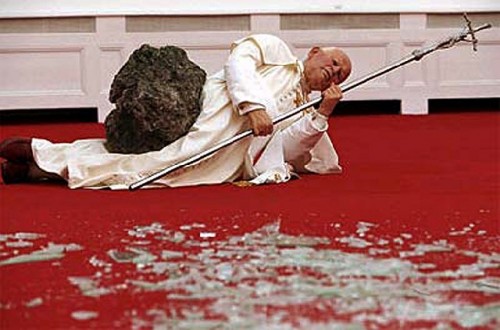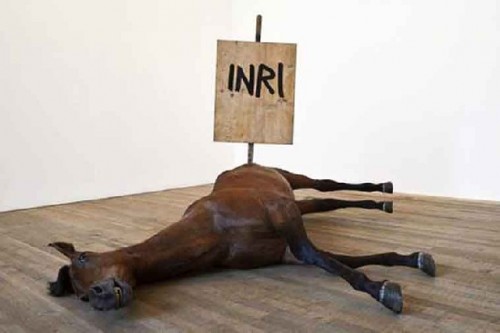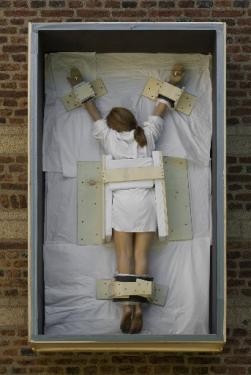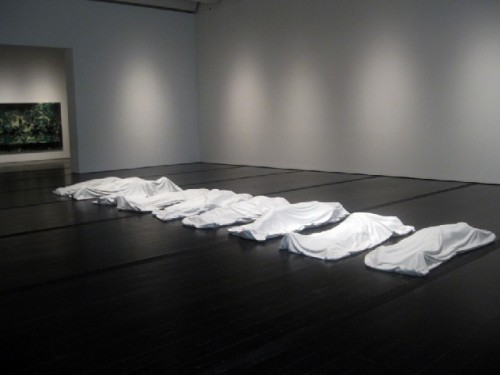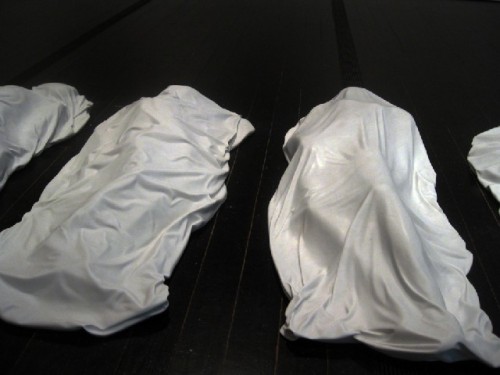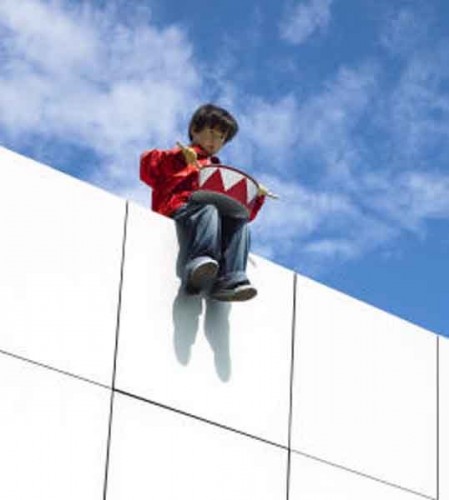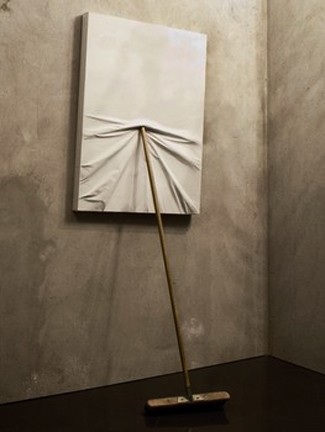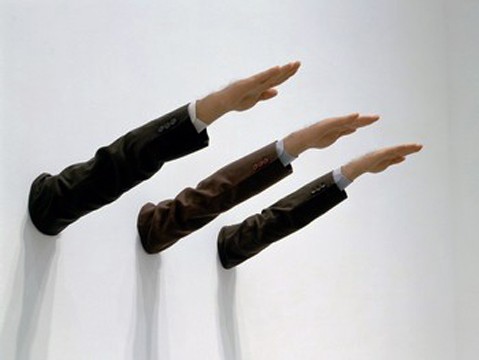Maurizio Cattelan at the Menil Collection
Shock and Awe in Houston to August 15
By: Charles Giuliano - May 20, 2010
The Menil Collection, in Houston, Texas is regarded as one of finest museum in North America. Every example of Surrealism, 20th Century and Contemporary Art, African Art, Native American, Neolitihic, Ancient Greek, Roman and Egyptian is of matchless quality. While relatively small and compact the collection conveys exquisite taste and the pursuit of pieces that conflate into one of the world’s great collections.
In addition to its primary building in the residential Museum District of Houston there are satellite structures within walking distance. The most famous of these is an art pilgrimage destination, The Rothko Chapel. There are similar, individual spaces devoted to Cy Twombly, Dan Flavin and a Byzantine dome.
One encounters the Menil Collection as a sublime experience. It is approached with unrushed reverence and keen attention. Every single piece is an unique experience. There was a kind of sublime reverie as we circulated through the galleries.
The Menil is particularly noted for its superb examples of Surrealism.
But we were stopped dead in our tracks encountering a dead horse lying on its side. Stuck into it was a sign with the crude inscription INRI. It references "Iesvs Nazarenvs Rex Ivdaeorvm." Or "Jesus of Nazareth King of the Jews." This mocking proclamation was placed above the crucified Christ by the Roman soldiers who executed him.
Just what does that have to do with a dead horse? It was our first encounter with an exhibition or intervention by the radical and controversial Italian artist Mauricio Cattelan. After visits to Houston the artist when working with Franklin Sirmans, Curator of Modern and Contemporary Art, devised an installation in which his work was dispersed throughout the museum.
This created an experience that was exciting and intriguing as well as deeply disturbing. The project which remains on view through August 15 has caused shock and controversy. Not just with the general public but also among informed individuals in Houston’s very hip and sophisticated arts community.
For many the interventions of Cattelan are a travesty and violation of hallowed ground.
Which is precisely what the artist is all about. He caused a sensation some time ago with a realistic rendering of Pope John Paul II, in full regalia, seemingly felled by a meteor. With tongue in chic he played on the notion of an “act of God.”
What a naughty boy.
In Houston he had the curator take down some iconic paintings by Mark Rothko to install the insultingly titled Ave Maria. It comprises three arms outstretched from the wall in what appear to be Nazi salutes. Most viewers fail to see the irony and humor. It does of course entirely throw off viewing the other masterpieces in the room. This artist has no respect. Starting with Rothko and ending with the viewer.
If it is the intention of the artist to shake up Houston, which is his practice, then this was an unqualified success. He has achieved a level of emotional intensity not experienced since Manet exhibited Olympia in the Paris Salon in 1863. It was a lot simpler to get a rise out of folks back in the day.
From the Horse we continued into the modern and contemporary galleries which comprise roughly half of the museum. There was a large gallery with a row of “victims” of an unidentified disaster. The dead bodies could be made out through the contours of the shrouds that covered them.
Initially the color and shape suggested sheets placed over mannequins. Upon closer inspection we were astonished to find that the life size forms had been carved from white Carrarra marble. Like most 19th century sculptors it is likely that the individual works were carved by craftsmen after the bozzetti of Cattelan. We speculated on how the works were designed and executed. We wondered in his practice just how much of the realistic sculpture in wax and marble is created directly by the hand of the artist.
Just what was the tragedy implied by the line of draped corpses? Was this a mass execution of rebels, victims of a suicide bombing, or casualties of a natural disaster? Surely contemporary society invites all of these possibilities. What point was the artist making? Perhaps we are invited to bring to it our own nightmares and associations.
Given the large space it occupied we also speculated on what we were missing. The next gallery displayed a large camouflaged Last Supper by Warhol.
Turning a corner in a medieval gallery there she was. A strikingly beautiful figure of a woman crucified and strapped down in what appeared to be a shipping container. We did not see her face but speculated on her beauty based on realistic blonde hair and the agile figure of a young woman. Again, was this act anof a serial killer? Perhaps an example of extreme bondage? Were we meant to evoke sympathy, empathy or erotic arousal? It was the second piece in the suite that evoked crucifixion and its obvious religious reference. What is his hang-up with Jesus?
To what extent does struggle and estrangement from Catholicism become a factor in understanding the work of Cattelan? He vividly references and signifies but coyly avoids articulating motives. It is all so compellingly and enigmatically voyeuristic. Is he just a juvenile delinquent? When if ever will he grow up?
In another gallery the small scale of the bed with two supine realistic, clothed male figures made one wonder if indeed it was another work by Cattelan. There were other possible candidates. It was an amusing piece that reminded me of the British artist Ron Mueck and work I saw at the London National Gallery. Looking at photos of Cattelan the figure, or one of them, may have been a self portrait.
There were other interventions as we made our way through the galleries. I came to anticipate, as well as dread, further discoveries. It was actually pleasurable to emerge from a gallery in which there were no more Cattelans.
And what about the stuffed dogs? Between them is a stuffed chick. It was just too cute and absurdly stupid. This artist can be so over the top that it is just dumb. Or, suspended over our heads, the hand pointing down with one middle finger. The rest of the fingers were amputated. Duh.
Overall, it is difficult to conclude whether the project enhanced or diminished our first visit to the sublime Menil Collection. It was late in the day and we wanted to visit the satellite buildings. An attendant was helpful but urged us to not miss the little drummer boy by Cattelan on the roof.
Dashing off to Rothko, what doesn’t seem right about that, we never looked back. Yes, the visit to the chapel was galvanic and restive. After Cattelan we needed some true spirituality. It is just not right to mix Rothko and Cattelan’s black mass. We will return to Rothko another time after we have exorcized Cattelan.
Of course one always risks the philistine. Only time will prove whether the work of Cattelan has depth and longevity. Or is just a sensational blip. For critics that is always the most challenging and dangerous judgment call. But it also demonstrated the greatness of the Menil that its curators are willing to take outrageous chances. In that sense its reputation remains untarnished by this extreme but equivocal incident.

